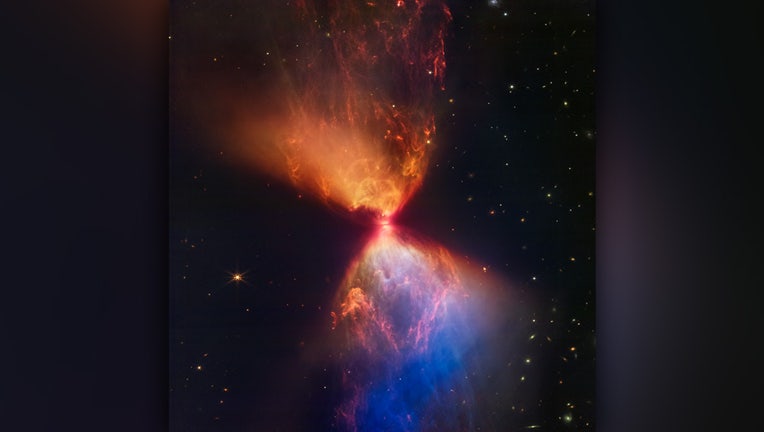James Webb telescope's new image unveils a new star form, displaying ‘fiery hourglass’

The protostar within the dark cloud L1527, shown in this image from NASA’s James Webb Space Telescope Near-Infrared Camera (NIRCam), is embedded within a cloud of material feeding its growth. (Courtesy: NASA, ESA, CSA, STScI / IMAGE PROCESSING: Josep
The beginnings of a new star were captured by NASA’s James Webb Space Telescope, and like many other images from the JWST, it is just as mesmerizing.
Known as protostar L1527 IRS, the new star is located in a nebula of the constellation Taurus.
An image taken by the James Webb Space Telescope shows the protostar illuminating part of the nebula, with beams of light creating a bright, hourglass shape set upon the backdrop of dark clouds of dust and gas.
The top half of the "hourglass" reveals clouds of gas and dust in shades of orange and bronze, while clouds on the bottom half are awash in blues and lavenders.
Such a vibrant display of colors is due to the clouds only being visible in infrared light, allowing them to be captured by the Near-Infrared Camera (NIRCam) on the James Webb Space Telescope.
The image captured by JWST is a representative-color infrared image, meaning that the colors represent the density of the gas and dust clouds being illuminated – not the colors of the clouds themselves.
RELATED: Large section of destroyed space shuttle Challenger found on ocean floor
Areas where cloud material is the thinnest, are shown in blue, while areas where they are thickest appear in orange.
At the "neck" of the colorful hourglass lies the protostar. While hidden from direct view in the image, signs of the protostar can be seen by the light being emitted above and below a dark line in the middle of the neck. It is this light that forms the illuminated "hourglass" in the nebula.
The dark line indicating the location of the protostar is a protoplanetary disk, or a dense region where the material is clumping together, which surrounds the protostar. From this material, planets may eventually form.

NASA astrophysicist shares details on set of James Webb Space Telescope images
NASA shared additional images from the $10 billion telescope?s initial outward gazes, including two images of nebulas where stars are born and die in spectacular beauty and another shot showing an update of a classic image of five tightly clustered galaxies that dance around each other.
RELATED: Artemis I launch: A not-so-small step toward NASA’s next giant leap
Protostar L1527 is relatively young at only about 100,000 years old – for comparison, our Sun is estimated to be 4.5 billion years old.
The protostar and protoplanetary disk encircling it is approximately the size of our solar system. It is a window into what our solar system may have looked like before the sun, and the planets took shape.

